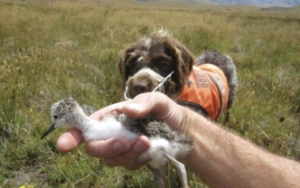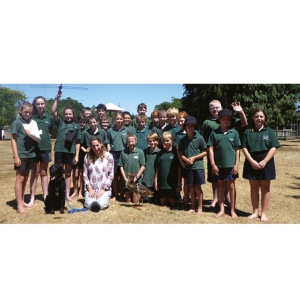Displaying items by tag: Protection
Protecting our kakī
As a ranger based in Twizel the main part of my job is supporting the Kakī Recovery Programme.
population in the wild and ensure this special bird is not lost for future generations.
As part of a small team of four permanent and a few seasonal staff, my responsibilities involve managing kakī in the wild. This includes counting how many adults are out there; traipsing up and down numerous braided rivers in the Mackenzie Basin searching for breeding pairs; observing and interpreting behaviour; finding their nests; reading leg bands and collecting eggs fromthe wild to bring back to the captive rearing facility in Twizel.
At 3–9 months they are released into the wild. Rearing them in captivity significantly increases their chances of survival by
preventing predation when they are most vulnerable and it also gets them through their first winter, which can be tough for young birds in the wild.
Whio in the spotlight
With less than 3000 whio around New Zealand, they need all the help they can get.
A two-day Whio Recovery Workshop was held in June at Tokaanu, near Turangi, where people with a passion for the endangered nativeblue duck gathered to hear information, ask questions and get what answers they could, although the overwhelming conclusion was that there is still lots more to be done.
More than 50 people involved in whio protection in the North Island took part in the workshop, which was held at the Genesis Energy Tokaanu Power Station.
The attendees were able to grow and maintain links with like-minded people, share their skills, learn more about research and consider some of the innovations being tried to ensure the safety of whio and increase its numbers. That included new and better ways to keep predators away and, if possible, eliminate themwith best practice monitoring and trapping techniques.
The workshop group also visited the Turangi Trout Fishery, where they were shown how to set and use predator traps and how to set nets to catch ducks.
The recovery programme involves not only paid workers, but private organisations and volunteers. They give up their own time to set traps, walk trap lines every two to three weeks,and keep an eye on the ducks at the same time.
This workshop was not just a talkfest, but included the chance to learn about the latest research and tools, and take part in practical demonstrations such as trap maintenance and safety.
Threats to whio
Introduced predators are the whio’s worst enemies. A whio recovery plan includes trapping and the use of toxins to reduced predators. Without such work, there would be no whio.
Stoats are the main killers, along with ferrets, feral cats, falcons and dogs. But events such as floods, that scour out riverbanks, can take away the whio’s food source. Even resource consents, water use and discharge of dirty water are a threat. Then, for the females, their moulting phase makes them vunerable to predators, as they cannot fly away.
The recovery project, without which the whio would be gone, is expensive and a significant partner is a necessity. Genesis Energy has stepped in to provide funding - $2 million overfive years - and its staff have become involvedin helping with recovery projects.
In the early 1980s, the Moawhango Tunnel was commissioned in the upper Tongariro River and whio numbers decreased in that area because of the changed flow volumes of the river. By 2004, however, work was done to create a minimum flow and the population rebounded.
Predation remains the key risk
Around the country, both Government workers and volunteers continue to trap predators and take care of eggs. Floods can wipe out a whole season’s ducklings. There is also a need to increase gender diversity and the transfer of juveniles to other areas helps with this.
Recent use of DOC200 traps and double set traps (where two predators are caught in the same trap), along with aerial 1080 drops, have helped survival. David Rogerson reported setting 85 traps and catching 50 rats a fortnight along the Maramataha River in the King Country. Malcolm Swanney trained Fern, a German short-haired pointer dog, to become a champion whio finder who will never hurt a bird.
The Ruahine Ranges
Janet Wilson, a keen tramper from the Manawatu, started work as a DOC volunteer trapper in 2011 in the Ruahines.
The Ruahine Whio Protection Trust was formed as a collective and now a strong group of volunteers works along120 kilometres of the range. Many drive to Napier and work the Napier ridge to the Orva and back south. There are 1500 traps and it is steep terrain.
Wellington Tramping and Mountaineering Club volunteers drive to Hawke’s Bay once a month to check and manage traps from that side.
Janet said she was disappointed that not enough protection work was done by DOC. Along those ranges there were 60 huts, mostly old. There are 500 plus tracks, and lots of rivers. “We have seven groups working together as a collective and using DOC200 traps.”
Jessica Scrimgeour said Janet and the collective have worked hard to keep the system going. “Janet’s commitment has driven the plan over the years.”
Taranaki trial
A trial whio recovery plan was put in place during 1999-2000 in Taranaki to investigate a viable population. Fifteen birds were introduced, but, for a variety of reasons, did not survive. The group persevered with stoat control in 2002 and in 2008, they released 170 ducks, with a 50-50 gender balance.
Between 2011 and 2016, the number of pairs has been good with a survival rate of about 81 percent. The next phase is to increase gender diversity. Predator control remains essential, but it was also found that it is best to transfer juveniles and not adults to other areas.
Some New Zealand Deer Stalkers Association members have agreed to help out by checking traps while out hunting.
Tongariro
Rachel Abbot talked about the Kia Whariti biodiversity project, which also involves DOC and Genesis Energy, in the 20,000-hectare Tongariro forest, bordered by the Whakapapa, Whanganui and Mangatepopo rivers, where they are using DOC 200 traps plus double set traps, and aerial 1080 drops. Since 2007, trapping has been in progress with 700 traps along the trap line.
Future threats
Another possible threat to whio is plantation forestry logging. However, recent information suggests that forestry companies who are aware of the presence of ducks will move their operations away from any nesting sites until the chicks have left.
The Whio Workshop was a success, but there’s such a lot to do, so let’s hope it will lead to more protection for the lovely whio. Alison Beath, the convenor, a senior ranger with DOC, is to be congratulated on the event.
Tracker dog helps find and protect birds
Emma Williams and I are helping the South Wairarapa Schools - Martinborough, Pirinoa and Kahutara - to achieve some of their environmental studies assignments and general objectives.
Emma has visited Kahutara School once already and her talk was very successful, she had her dog Kimi with her and the children loved that.
Then Emma went up to Hawke’s Bay and further north where she worked with older young people. Emma has developed a package for schools on wetlands and wetland birds with bitterns in particular, and where they are in the habitat.
Emma’s lovely black labrador Kimi, helps with her work and accompanies her on visits to schools.
We will start another series of school visits in the South Wairarapa during August and plan to visit Wairio wetlands at some stage and track bitterns that have radio transmitters attached to them.
The overall plan is to introduce pupils to wetland conservation and so attract some new young members for Ducks Unlimited!
Gill Lundie


